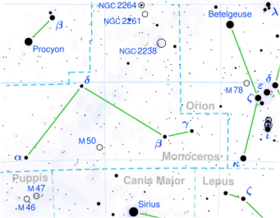Astronomy:Delta Monocerotis
| Observation data Equinox J2000.0]] (ICRS) | |
|---|---|
| Constellation | Monoceros |
| Right ascension | 07h 11m 51.860s[1] |
| Declination | −00° 29′ 33.96″[1] |
| Apparent magnitude (V) | 4.15[2] |
| Characteristics | |
| Spectral type | A2V[3] or A0IV[4] |
| U−B color index | +0.04[5] |
| B−V color index | +0.00[5] |
| Astrometry | |
| Radial velocity (Rv) | +15.0±4.1[6] km/s |
| Proper motion (μ) | RA: +0.79[7] mas/yr Dec.: +4.52[7] mas/yr |
| Parallax (π) | 8.49 ± 0.17[7] mas |
| Distance | 384 ± 8 ly (118 ± 2 pc) |
| Absolute magnitude (MV) | −1.20[2] |
| Details | |
| Mass | 2.4+0.43 −0.38[3] M☉ |
| Luminosity | 350[8] L☉ |
| Surface gravity (log g) | 3.5±0.25[3] cgs |
| Temperature | 9,462[8] K |
| Metallicity [Fe/H] | 0.00[9] dex |
| Rotational velocity (v sin i) | 175.5±1.3[10] km/s |
| Age | 405+135 −207[3] Myr |
| Other designations | |
| Database references | |
| SIMBAD | data |
Delta Monocerotis, which is Latinized from δ Monocerotis, is a single star[12] in the constellation of Monoceros, positioned about a half degree south of the celestial equator. It has a white hue and is faintly visible to the naked eye with an apparent visual magnitude of 4.15.[2] The distance to this star is approximately 384 light years based on parallax.[7] It is drifting further away from the Sun with a radial velocity of about +15 km/s,[6] having come to within 88 light-years some 7.3 million years ago.[2] The star has an absolute magnitude of −1.20.[2]
The Bright Star Catalogue assigns this star a stellar classification of A2V, suggesting this is an A-type main-sequence star.[3][13] However, Houk and Swift (1999) found a more evolved subgiant class of A0IV.[4] It has around 2.4 times the mass of the Sun and is an estimated 405 million years old.[3] The star has a high rate of spin with a projected rotational velocity of 175.5 km/s,[10] giving it an equatorial bulge that is 5% larger than the polar radius.[14] It is radiating 350 times the luminosity of the Sun from its photosphere at an effective temperature of 9,462 K.[8]
It has one reported visual companion, designated component B, at an angular separation of 32.0″ and visual magnitude 13.0.[15]
References
- ↑ 1.0 1.1 Høg, E. et al. (2000). "The Tycho-2 catalogue of the 2.5 million brightest stars". Astronomy and Astrophysics 355: L27. Bibcode: 2000A&A...355L..27H.
- ↑ 2.0 2.1 2.2 2.3 2.4 Anderson, E.; Francis, Ch. (2012). "XHIP: An extended hipparcos compilation". Astronomy Letters 38 (5): 331. doi:10.1134/S1063773712050015. Bibcode: 2012AstL...38..331A. Vizier catalog entry
- ↑ 3.0 3.1 3.2 3.3 3.4 3.5 Gullikson, Kevin et al. (August 2016). "The Close Companion Mass-ratio Distribution of Intermediate-mass Stars". The Astronomical Journal 152 (2): 13. doi:10.3847/0004-6256/152/2/40. 40. Bibcode: 2016AJ....152...40G.
- ↑ 4.0 4.1 Houk, N.; Swift, C. (1999). "Michigan catalogue of two-dimensional spectral types for the HD Stars". Michigan Spectral Survey 5. Bibcode: 1999MSS...C05....0H.
- ↑ 5.0 5.1 Mallama, A. (2014). "Sloan Magnitudes for the Brightest Stars". The Journal of the American Association of Variable Star Observers 42 (2): 443. Bibcode: 2014JAVSO..42..443M.Vizier catalog entry
- ↑ 6.0 6.1 Gontcharov, G. A. (2006). "Pulkovo Compilation of Radial Velocities for 35 495 Hipparcos stars in a common system". Astronomy Letters 32 (11): 759–771. doi:10.1134/S1063773706110065. Bibcode: 2006AstL...32..759G.
- ↑ 7.0 7.1 7.2 7.3 Van Leeuwen, F. (2007). "Validation of the new Hipparcos reduction". Astronomy and Astrophysics 474 (2): 653–664. doi:10.1051/0004-6361:20078357. Bibcode: 2007A&A...474..653V. Vizier catalog entry
- ↑ 8.0 8.1 8.2 Zorec, J.; Royer, F. (2012). "Rotational velocities of A-type stars". Astronomy & Astrophysics 537: A120. doi:10.1051/0004-6361/201117691. Bibcode: 2012A&A...537A.120Z. Vizier catalog entry
- ↑ Gontcharov, G. A. (2012). "Dependence of kinematics on the age of stars in the solar neighborhood". Astronomy Letters 38 (12): 771–782. doi:10.1134/S1063773712120031. Bibcode: 2012AstL...38..771G. Vizier catalog entry
- ↑ 10.0 10.1 Díaz, C. G. et al. (July 2011). "Accurate stellar rotational velocities using the Fourier transform of the cross correlation maximum". Astronomy & Astrophysics 531: A143. doi:10.1051/0004-6361/201016386. Bibcode: 2011A&A...531A.143D.
- ↑ "del Mon". SIMBAD. Centre de données astronomiques de Strasbourg. http://simbad.u-strasbg.fr/simbad/sim-basic?Ident=del+Mon.
- ↑ Eggleton, P. P.; Tokovinin, A. A. (September 2008). "A catalogue of multiplicity among bright stellar systems". Monthly Notices of the Royal Astronomical Society 389 (2): 869–879. doi:10.1111/j.1365-2966.2008.13596.x. Bibcode: 2008MNRAS.389..869E.
- ↑ Hoffleit, D.; Warren, W. H. (1995). "Bright Star Catalogue, 5th Revised Ed. (Hoffleit+, 1991)". VizieR On-line Data Catalog: V/50. Originally Published in: 1964BS....C......0H 5050. Bibcode: 1995yCat.5050....0H.
- ↑ van Belle, Gerard T. (March 2012). "Interferometric observations of rapidly rotating stars". The Astronomy and Astrophysics Review 20 (1): 51. doi:10.1007/s00159-012-0051-2. Bibcode: 2012A&ARv..20...51V.
- ↑ Dommanget, J.; Nys, O. (2002). "VizieR Online Data Catalog: CCDM (Catalog of Components of Double & Multiple stars) (Dommanget+ 2002)". VizieR On-line Data Catalog: I/274. Originally Published in: Observations et Travaux 54 1274. Bibcode: 2002yCat.1274....0D. Vizier catalog entry
 |


